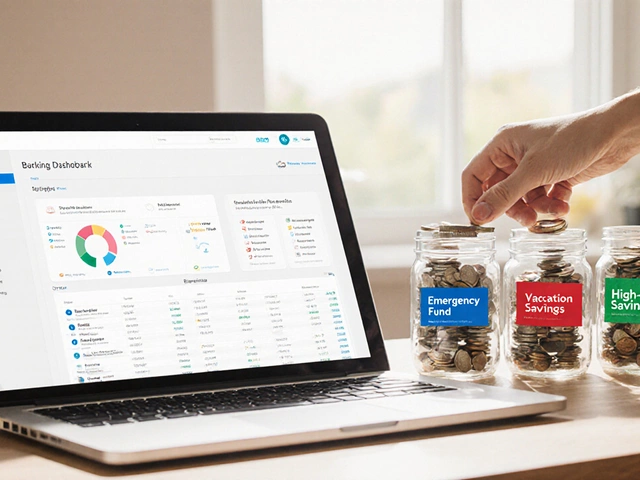
Ever found yourself wondering which mutual funds in India can really jack up your returns? You're not alone. With so many choices buzzing around, knowing where to park your money can feel like a maze. But fear not, because we're about to break it down for you.
Let's start with the takeaway: equity-oriented funds usually steal the show when it comes to beefy returns. These are the funds that pour your money into stocks, aiming to ride the highs of market growth. Sure, they come with their own share of bumps and spins, but the potential pay-offs have investors coming back for more.
Does this mean equity funds are your go-to? Well, not always. It depends on your risk appetite. High returns often dance hand in hand with higher risk. But here's where a diversified strategy plays superhero—spreading your investments to balance risk and reward, ultimately aiming for a win in the long game.
- Understanding Mutual Funds
- Equity Funds: The High Flyers
- Role of Market Trends
- Risk vs Return
- Tips for Choosing the Right Fund
- Future of High Return Funds
Understanding Mutual Funds
Diving into the world of mutual funds India, let's kick things off with the basics. A mutual fund is all about pooling your bucks with other investors to buy a bunch of stocks, bonds, or other securities. It’s like having a membership in a club where the fund manager does the heavy lifting in terms of managing the portfolio.
The fun part? You don't need a heap of cash to start. With options like SIPs (Systematic Investment Plans), you can invest small amounts regularly, which is great if you're just baby-stepping into the investment world.
Types of Mutual Funds
So, what types of mutual funds are out there? Generally, they fall into three big buckets:
- Equity Funds: These invest mainly in stocks. They usually offer the highest returns but come with more risk.
- Debt Funds: If safety makes you sleep better, debt funds invest in fixed interest-generating securities. Think fewer highs, but fewer lows too.
- Hybrid Funds: Can’t decide? Hybrid funds are a mix of both equity and debt. It’s like having your cake and eating it too—kinda.
Now, each type has its own logic—equity funds are about growth, debt funds focus on stable income, and hybrid funds aim to balance it all.
How Mutual Funds Work
Here's a glimpse under the hood. A mutual fund sells shares to the public. When you buy shares, you're buying a slice of the whole asset pie. The value of these shares is reflected in the Net Asset Value or NAV, which fluctuates based on the market's performance.
Mutual funds are great for budding investors as they offer a chance to diversify investments more than you could on your own. Plus, you’re getting expert management without the hassle of picking individual stocks.
One cool stat worth mentioning: The Indian mutual fund industry saw a growth of about 40% in the number of accounts from 2020 to 2023, showing just how popular these investments have become.
Equity Funds: The High Flyers
When it comes to grabbing high returns in the Indian mutual funds game, equity funds often lead the pack. They pump your money into the stock market, and if the market's on a roll, your returns could soar. Why? Because you're riding the wave of company growth, stock appreciation, and dividends.
Not all equity funds are cut from the same cloth, though. You've got different flavors to choose from, depending on where your comfort level with risk sits. Here's a quick look at a few types:
- Large-cap funds: These focus on established companies known for stability. They might not offer sky-high returns at lightning speed but tend to minimize risk.
- Mid-cap and small-cap funds: Want more risk for potentially higher returns? These funds invest in smaller or mid-sized companies poised for growth, sometimes achieving impressive returns, albeit with more volatility.
- Multi-cap funds: These mix and match across company sizes. The diversified approach helps balance risk and reward.
Why Choose Equity Funds?
So, why go with equity funds if risk is a factor? Historically, over an extended period, the stock market has outpaced other types of investments, offering robust returns. Add to that, equity funds are professionally managed, which saves you the headache of picking stocks yourself.
Sure, spending time in the market is risky, but with the help of an advisor, or some diligent research, you can position yourself for long-term gain. Plus, equity funds offer the opportunity for tax advantages under certain conditions in India.
Equity Fund Stats: A Snapshot
Check out this table that highlights how equity funds performed in recent years:
| Year | Average Return (%) | Category Rank |
|---|---|---|
| 2022 | 12% | 3rd |
| 2023 | 15% | 2nd |
| 2024 | 10% | 4th |
Notice the variability? That's the name of the game. By analyzing market trends and diversifying your portfolio, you can use this info to your advantage.
Role of Market Trends
Ever notice how certain mutual funds seem to thrive during market highs while others weather downturns better? That's the impact of market trends on mutual funds in India. Trends can shift based on a lot of factors, like changes in government policy, global events, or shifts in consumer behavior. Understanding these trends can be a game-changer for your investment choices.
Here's the deal: when the stock market is on an upswing, equity funds typically perform well. They’re riding the wave of robust returns as company shares rise in value. But when volatility hits, it can be a rocky ride. That's when more conservative funds might appeal.
Why Market Trends Matter
Keeping an eye on market trends can help you predict which types of funds might have a better run. For instance, during a market boom, sectors like technology and energy might offer exciting opportunities, pushing specific funds into the spotlight. Conversely, in a down market, defensive sectors like utilities or healthcare often become more attractive.
Tracking and Analyzing Trends
To get the best from your investment strategies, it's vital to stay informed. Here are a few tips:
- Follow financial news channels and reliable online platforms.
- Read market analysis reports from credible sources.
- Check historical performance data of funds during different market phases.
Finally, remember that while trends offer guidance, they shouldn't be your sole consideration. Nothing beats a well-rounded investment strategy, tailor-made to fit your own financial goals and risk tolerance.

Risk vs Return
When it comes to mutual funds, risk and return are like two sides of the same coin. It's a classic trade-off every investor faces. Want those sky-high returns? You've got to be ready to stomach some ups and downs along the way.
In the realm of mutual funds in India, equity funds are the rockstars known for high returns, but they also come with a roller coaster of risks. The market swings affect them, and sometimes, it may feel like a poker game. But why take the risk? The potential returns can be substantially higher compared to more mellow options like debt funds.
"The art of investing is about making decisions based on your risk tolerance, goals, and time frame," says Rakesh Jhunjhunwala, a renowned Indian investor, often referred to as the Warren Buffet of India.
Assessing Your Risk Tolerance
Your personal risk tolerance is your comfort zone in this game. Younger investors might have a higher risk appetite since they have time to ride out market volatility. On the flip side, someone nearing retirement might play it safe with less volatile funds.
Balancing Risk
Diversification is the name of the game when it comes to managing risks. By spreading your investments across different asset classes, you’re not putting all your eggs in one basket. Ever heard of a balanced fund? It invests in both equities and debts, aiming for a more stabilized return.
Here's a simple table to catch a quick eye on risk vs return:
| Fund Type | Potential Return | Risk Level |
|---|---|---|
| Equity Funds | High | High |
| Debt Funds | Medium | Low |
| Balanced Funds | Medium-High | Medium |
At the end of the day, knowing your risk tolerance and having clear investment goals can help you make informed decisions. Whether you’re reaching for the stars with equity funds or playing it safe with debt, the key is finding that sweet spot that matches your financial aspirations and comfort zone.
Tips for Choosing the Right Fund
So you're ready to jump into the world of mutual funds India, but what's the game plan? Picking the right fund can feel like a balancing act, but it doesn't have to be a head-scratcher. Here’s a no-nonsense guide to make sure you’re on the right track.
1. Know Your Goals
First things first, ask yourself what you want from your investment. Are you saving for a new house, or eyeing long-term wealth? Your goals will steer the ship on whether a steady income fund or a high-octane equity fund is your best bet.
2. Understand the Risk
Let’s not kid ourselves. High returns come with some twists and turns. If you're not all about the thrills and spills, look for funds with a balance between risk and reward. Knowing your risk tolerance is like knowing your coffee preference: it makes a huge difference.
3. Check the Performance History
Don’t just follow the hype without doing your homework. Look at funds with a solid performance track record over at least 5-10 years. It's like picking a movie to watch—past blockbusters are usually a good sign.
4. Expense Ratio Matters
Ever heard of the expense ratio? It’s what a fund charges to manage your money. Lower is better because that means less of your return is going into somebody else’s pocket. So keep an eye on this sneaky little number.
5. Manager Experience
The fund manager is like your favorite chef; their skills will make or break your experience. Look for funds with seasoned managers who’ve weathered market storms. Veteran managers can be the secret sauce to your investment success.
6. Diversification is Key
Spread the love! Diversification is all about not putting all your eggs in one basket. Mix it up between high-risk and low-risk funds to ride out the ups and downs of the market.
Here's a quick snapshot on some factors to consider:
| Factor | Importance |
|---|---|
| Investment Goals | Crucial |
| Risk Level | High |
| Performance History | Important |
| Expense Ratio | Moderate |
By keeping these tips front and center, choosing a high return fund that aligns with your financial goals won’t just be a shot in the dark. It’ll be a step towards smart investing.
Future of High Return Funds
Alright, so you're probably wondering what the future holds for high return mutual funds in India. The landscape is always changing and keeping an eye on the trends can give your investments a serious edge.
Technology and Innovation
Technology's impact is massive—automated trading systems and AI-driven analysis are making waves. These advances might help fund managers spot opportunities with pinpoint accuracy, potentially boosting returns. For individual investors, this could mean more strategies tailored to maximizing your profits.
Focus on Sustainability
Sustainable investing is booming. Funds focusing on eco-friendly and ethically sound companies are gaining traction. No longer just a buzzword, it seems 'green' investing could soon become 'golden,' providing solid returns while doing good for the planet.
Regulatory Changes
Watch out for regulatory shifts! They could usher in products or rules that make high returns more accessible or protect investors better. Staying informed about these could offer new, lucrative avenues for investment.
Now, a quick peek at some expected trends via these stats:
| Year | Expected Growth Rate |
|---|---|
| 2025 | 10% |
| 2026 | 12% |
Planning your moves based on what lies ahead is crucial. That means adapting to tech, considering green options, and being mindful of regulations. All this can help grow your wealth and stay ahead in the ever-competitive game of high return mutual funds.








Write a comment